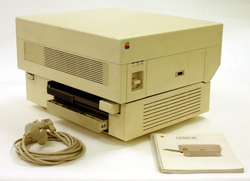Reading the comment threads on Tech.pinions’ many posts on Apple v. Samsung and iOS vs. Android, I have been struck by the recurring charge that Apple is nothing but a clever marketer that does nothing but copy (impolite version: steal) and repackage the work of others. To anyone knowledgeable about the history of the industry, this is pure nonsense I’m not sure that evidence will do much to persuade the doubters. Nonetheless, here are three critical Apple innovations that reshaped the tech industry:
 Desktop Publishing. The laser printer was invented by Xerox in the late 1960s and developed in the 1970s by Canon, Ricoh, and Hewlett-Packard. But in the mid-80s, nearly all “letter quality” printers relied on typewriter technology. Apple had the vision to combine the capabilities of the laser printer, the new Macintosh, and Adobe’s PostScript page-description language to put something resembling professional page composition on the desktop. Apple’s LaserWriter printers were not terribly successful and the company decided to leave printing to HP and others after a few years. But Apple’s early commitment to the technology set the stage for the desktop publishing revolution that not only made gave every computer user the tools of the graphic artist but revolutionized commercial publishing.
Desktop Publishing. The laser printer was invented by Xerox in the late 1960s and developed in the 1970s by Canon, Ricoh, and Hewlett-Packard. But in the mid-80s, nearly all “letter quality” printers relied on typewriter technology. Apple had the vision to combine the capabilities of the laser printer, the new Macintosh, and Adobe’s PostScript page-description language to put something resembling professional page composition on the desktop. Apple’s LaserWriter printers were not terribly successful and the company decided to leave printing to HP and others after a few years. But Apple’s early commitment to the technology set the stage for the desktop publishing revolution that not only made gave every computer user the tools of the graphic artist but revolutionized commercial publishing.
 The legacy-free computer. In 1998, every computer was expected to have a floppy drive. Windows PCs came with PS/2 ports to connect a keyboard and mouse, a parallel port for a printer, and a serial port for other chores, such as syncing a Palm Pilot. Macs replaced those connectors with the proprietary AppleDesktop Bus and LocalTalk ports. That spring, Steve Jobs, who had just resumed the helm of Apple, introduced the original iMac. In addition to looking completely different from any computer anyone had ever seen, the iMac dispensed with both the floppy and all legacy ports, replacing them with Universal Serial Bus connectors. USB had been around for a while and was standard equipment on all Intel motherboards, but since Windows didn’t reliably support USB until Windows 98 Second Edition in mid-1999, they were barely used. Apple, which was still in very shaky financial condition, got scathing criticism for its leap into the future. But while floppies and legacy ports persisted on Windows machines for years, the iMac was a runaway success and suddenly all those indispensable legacies became dispensable indeed. (The iMac’s USB “hockey puck” mouse was a less brilliant idea and was soon replaced by a more conventional design.)
The legacy-free computer. In 1998, every computer was expected to have a floppy drive. Windows PCs came with PS/2 ports to connect a keyboard and mouse, a parallel port for a printer, and a serial port for other chores, such as syncing a Palm Pilot. Macs replaced those connectors with the proprietary AppleDesktop Bus and LocalTalk ports. That spring, Steve Jobs, who had just resumed the helm of Apple, introduced the original iMac. In addition to looking completely different from any computer anyone had ever seen, the iMac dispensed with both the floppy and all legacy ports, replacing them with Universal Serial Bus connectors. USB had been around for a while and was standard equipment on all Intel motherboards, but since Windows didn’t reliably support USB until Windows 98 Second Edition in mid-1999, they were barely used. Apple, which was still in very shaky financial condition, got scathing criticism for its leap into the future. But while floppies and legacy ports persisted on Windows machines for years, the iMac was a runaway success and suddenly all those indispensable legacies became dispensable indeed. (The iMac’s USB “hockey puck” mouse was a less brilliant idea and was soon replaced by a more conventional design.)
![]() Wi-Fi. No, Apple didn’t invent Wi-Fi, or, as it was originally called, wireless Ethernet. That honor goes to AT&T (later Lucent) Bell Labs. But Apple began putting AirPort cards (actually rebranded Lucent Orinoco PCMCIA cards) into Macs, including some desktops, in 1999, before the IEEE even completed the agonizingly slow process of ratifying the 802.11b standard that it was based on. (Here’s a 1999 article I wrote on Apple’s offerings.) Slower versions of the 802.11 standard had been around for a while for commercial and industrial use, but Apple took the blindingly fast version (a theoretical 11 megabits per second, up from 2 mb/s) and turned it into a consumer product. Although others, particularly Intel, were later to play an important role in making Wi-Fi ubiquitous, it was Apple that had the vision that freed our computers from their network tethers.
Wi-Fi. No, Apple didn’t invent Wi-Fi, or, as it was originally called, wireless Ethernet. That honor goes to AT&T (later Lucent) Bell Labs. But Apple began putting AirPort cards (actually rebranded Lucent Orinoco PCMCIA cards) into Macs, including some desktops, in 1999, before the IEEE even completed the agonizingly slow process of ratifying the 802.11b standard that it was based on. (Here’s a 1999 article I wrote on Apple’s offerings.) Slower versions of the 802.11 standard had been around for a while for commercial and industrial use, but Apple took the blindingly fast version (a theoretical 11 megabits per second, up from 2 mb/s) and turned it into a consumer product. Although others, particularly Intel, were later to play an important role in making Wi-Fi ubiquitous, it was Apple that had the vision that freed our computers from their network tethers.
 WebKit. It’s easy to foget how awful mobile browsing was before the iPhone. Not only did most devices have minuscule displays, but the browsers on Palm, Symbian, BlackBerry. and Windows Mobile devices were just terrible. The WebKit browser engine that was the basis of the iPhone version of Safari totally changed the game by bringing desktop-class browsing to a handheld. Even though the original iPhone, which lacked 3G support, suffered from slow connections, it provided a vastly better browsing experience than anything we had seen before. Even better, it’s open source (not entirely by choice; WebKit was based on the KDE project’s open source KHTML) so it is widely used by other company’s browsers, including Google Chrome.
WebKit. It’s easy to foget how awful mobile browsing was before the iPhone. Not only did most devices have minuscule displays, but the browsers on Palm, Symbian, BlackBerry. and Windows Mobile devices were just terrible. The WebKit browser engine that was the basis of the iPhone version of Safari totally changed the game by bringing desktop-class browsing to a handheld. Even though the original iPhone, which lacked 3G support, suffered from slow connections, it provided a vastly better browsing experience than anything we had seen before. Even better, it’s open source (not entirely by choice; WebKit was based on the KDE project’s open source KHTML) so it is widely used by other company’s browsers, including Google Chrome.
Purists can complain that Apple didn’t invent any of these. But that’s the difference between invention and innovation. And while the cleverness and insights of the inventor are essential, we need the daring and vision of the innovator to move forward. The iMac in particular was an extremely gutsy move by Apple; Steve Jobs bet the company on a novel design and its failure would almost certainly have meant the end of Apple.
Even during Apple’s darkest days of the mid-1990s, Apple remained a remarkably inventive company. For example, the Newton MessagePad was a failure, but no one can say that it did not break significant new ground. There are many things you can fairly criticize Apple for, but the charge that the company fails to innovate is just plain silly.
*-There are three kinds of mathematicians–those who can count and those who can’t. The original headline said “three.” While writing the piece, I added the section on the LaserWriter, but forgot to change the headline.
